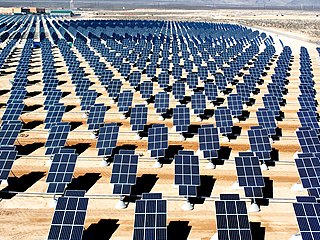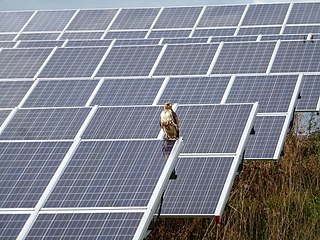| Mansa Solar Power Plant | |
|---|---|
| Country | India |
| Status | Operational |
| Commission date | 29 September 2016 |
| Construction cost | ₹ 200 crore |
| Solar farm | |
| Type | Flat-panel PV |
| Power generation | |
| Nameplate capacity | 31.5 MW |
Mansa Solar Power Plant is a 31.5 MW solar photovoltaic power generating station at Mirpur Kalan village of Mansa district in Punjab state of India. [1]
Built by Hindustan Power, it is the largest single location solar power plant in Punjab with a capacity of 31.5 MW. The plant is spread over 173 acres and project cost is over ₹ 200 crore. [2]
The plant was inaugurated on 29 September 2016 by Sukhbir Singh Badal, Deputy Chief Minister of Punjab. [2]

Many countries and territories have installed significant solar power capacity into their electrical grids to supplement or provide an alternative to conventional energy sources. Solar power plants use one of two technologies:

Solar power is a fast developing industry in India. The country's solar installed capacity was 63.303 GWAC as of 31 December 2022. Solar power generation in India ranks fourth globally in 2021.

Solar power in Nevada is growing due to a Renewable Portfolio Standard which requires 20% renewable energy by 2015, and 5% from solar power. The state has abundant open land areas and some of the best solar potential in the country.

Solar power in Arizona has the potential to, according to then-Governor Janet Napolitano, make Arizona "the Persian Gulf of solar energy". In 2012, Arizona had 1,106 MW of photovoltaic (PV) solar power systems, and 6 MW of concentrated solar power (CSP), bringing the total to over 1,112 megawatts (MW) of solar power. As an example, the Solana Generating Station, a 280 MW parabolic trough solar plant, when commissioned in 2013, was the largest parabolic trough plant in the world and the first U.S. solar plant with molten salt thermal energy storage.

India is world's 3rd largest consumer of electricity and world's 3rd largest renewable energy producer with 40% of energy capacity installed in the year 2022 coming from renewable sources. Ernst & Young's (EY) 2021 Renewable Energy Country Attractiveness Index (RECAI) ranked India 3rd behind USA and China. In November 2021, India had a renewable energy capacity of 150 GW consisting of solar, wind, small hydro power, bio-mass, large hydro, and nuclear. India has committed for a goal of 500 GW renewable energy capacity by 2030.

Pakistan has some of the highest values of insolation in the world, with eight to nine hours of sunshine per day, ideal climatic conditions for solar power generation. However, the country has been slow to adopt the technology. Electricity tariff in Pakistan is one of highest in the world, despite this as of 2022, total solar power energy of Pakistan is only 568 MWAC.

The energy sector in Hawaii has rapidly adopted solar power due to the high costs of electricity, and good solar resources, and has one of the highest per capita rates of solar power in the United States. Hawaii's imported energy costs, mostly for imported petroleum and coal, are three to four times higher than the mainland, so Hawaii has motivation to become one of the highest users of solar energy. Hawaii was the first state in the United States to reach grid parity for photovoltaics. Its tropical location provides abundant ambient energy.

Singrauli Super Thermal Power Plant is located at Shaktinagar in Sonebhadra district in Indian state of Uttar Pradesh. The power plant is the first power plant of NTPC. It sources coal from Jayant and Bina mines and water from Rihand Reservoir. The states benefitting from this power plant are Uttar Pradesh, Uttarakhand, Rajasthan, Punjab, Haryana and Himachal Pradesh and the Union Territories of Delhi, Chandigarh and Jammu and Kashmir. An investment worth ₹11,907 million (US$150 million) has already been cleared. It even gets international assistance from IDA.

Welspun Energy Private Limited is an independent power company based in New Delhi, India. It is a subsidiary of Welspun Group.

Adani Power is an Indian power and energy company which is a part of Adani Group. Based in Khodiyar in Ahmedabad, it is a private thermal power producer, with a capacity of 12,450 MW and operates a mega solar plant of 40 MW at Naliya, Bitta, Kutch, Gujarat.

Renewable energy in Russia mainly consists of hydroelectric energy. In 2010, the country was the sixth largest producer of renewable energy in the world, although it was 56th when hydroelectric energy was not taken into account. Some 179 TWh of Russia's energy production came from renewable energy sources, out of a total economically feasible potential of 1823 TWh. 16% of Russia's electricity was generated from hydropower, and less than 1% was generated from all other renewable energy sources combined. Roughly 68% of Russia's electricity was generated from thermal power and 16% from nuclear power.

A photovoltaic power station, also known as a solar park, solar farm, or solar power plant, is a large-scale grid-connected photovoltaic power system designed for the supply of merchant power. They are different from most building-mounted and other decentralised solar power because they supply power at the utility level, rather than to a local user or users. The generic expression utility-scale solar is sometimes used to describe this type of project.

Solar power in Michigan has been growing in recent years due to new technological improvements, falling solar prices and a variety of regulatory actions and financial incentives. The largest solar farm in Michigan is Assembly Solar, completed in 2022, which has 347 MW of capacity. Small-scale solar provided 50% of Michigan solar electricity as recently as 2020 but multiple solar farms in the 100 MW to 200 MW range are proposed to be completed by the middle of the decade. Although among the lowest U.S. states for solar irradiance, Michigan mostly lies farther south than Germany where solar power is heavily deployed. Michigan is expected to use 120 TWh per year in 2030. To reach a 100% solar electrical grid would require 2.4% of Michigan's land area to host 108 GW of installed capacity.
The Quaid-e-Azam Solar Park is a photovoltaic power station in Bahawalpur, Punjab, Pakistan, named in honor of Quaid-e-Azam Muhammad Ali Jinnah, the Founder of Pakistan. It is a 100 MW solar plant spanning 500 acres (200 ha) and hosting 392,158 solar modules. The project was constructed by the Government of Punjab, Pakistan in May 2015 with the cost of $131 million.

Kamuthi Solar Power Project is a photovoltaic power station spread over an area of 2,500 acres (10 km2) in Kamuthi, Ramanathapuram district, 90 km from Madurai, in the state of Tamil Nadu, India. The project was commissioned by Adani Power. With a generating capacity of 648 MWp at a single location, it is the world's 12th largest solar park based on capacity.

Pavagada Solar Park is a solar park covering an area of 53 square kilometres in Pavagada taluk, Tumkur district, Karnataka. Completed in 2019, the park has a capacity of 2,050 MW. As of April 2021, it is the World's third largest photovoltaic solar park after the 2,245 MW Bhadla Solar Park in Rajasthan and 2,200 MW Huanghe Hydropower Hainan Solar Park in China. The total project cost was ₹14,800 crore.
The Techren Solar Project is a 400 megawatt (MWAC) solar photovoltaic power plant near Boulder City, Nevada. Electricity production began with completion of the two building phases in 2019–2020. The project is co-located with several other large solar power projects in the Eldorado Valley.

Adani Green Energy Limited (AGEL) is an Indian renewable energy company headquartered in Ahmedabad, Gujarat. It is owned by Indian conglomerate Adani Group. The company operates Kamuthi Solar Power Project, one of the largest solar photovoltaic plants in the world.